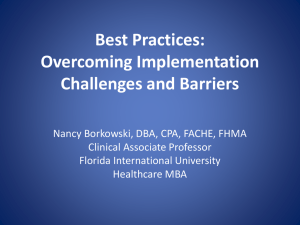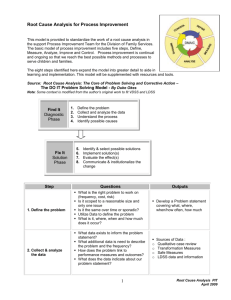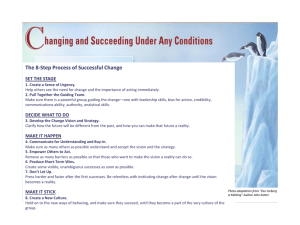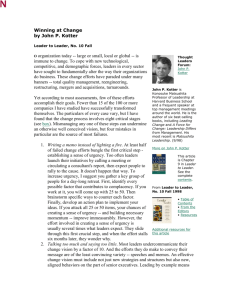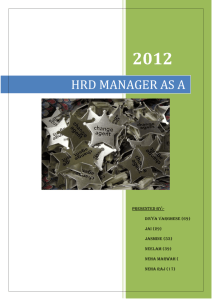Transforming Research Management Systems at Mayo Clinic: A
advertisement
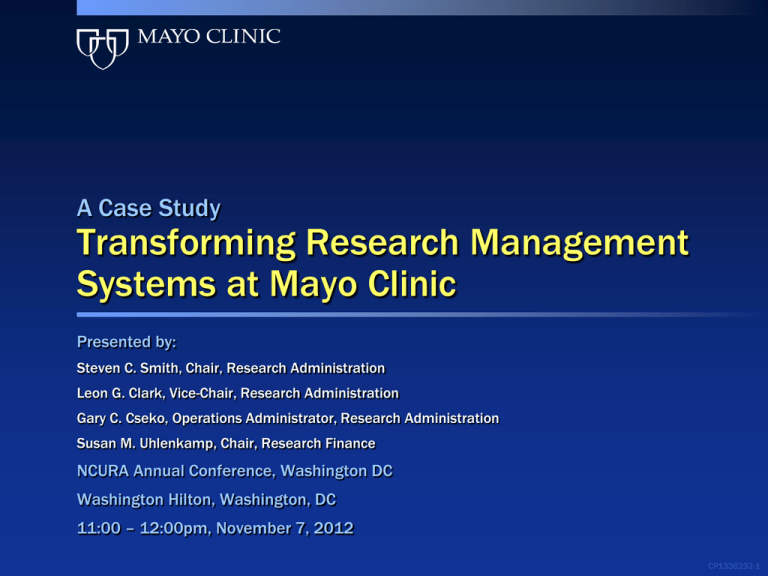
A Case Study Transforming Research Management Systems at Mayo Clinic Presented by: Steven C. Smith, Chair, Research Administration Leon G. Clark, Vice-Chair, Research Administration Gary C. Cseko, Operations Administrator, Research Administration Susan M. Uhlenkamp, Chair, Research Finance NCURA Annual Conference, Washington DC Washington Hilton, Washington, DC 11:00 – 12:00pm, November 7, 2012 CP1336232-1 Disclosure The presenters do not have any relevant financial relationships with any commercial interests. CP1336232-2 Presentation Outline Learning Objectives Overview Questions CP1336232-3 Learning Objectives Describe the Mayo quality improvement framework and how this framework can be applied in their organizations to improve the quality and transform business processes. Explain the transformation is a process that advances through a series of stages that build upon one another. Describe the eight stages of changes, the critical action steps to take and the common problems to avoid. CP1336232-4 Overview Mayo Clinic Overview Mayo Quality Framework Comprehensive Research Management System Stages of Transformation CP1336232-5 Mayo Clinic Locations Mayo Clinic Mayo Clinic Health System Mayo Clinic in Arizona Mayo Clinic in Florida ©2011 MFMER | slide-6 Mayo Clinic Research is… National research program Arizona, Florida, Minnesota In top 20 NIH-funded AMC’s 365 awards from 27 institutes Over 8,000 active human studies Over 3,000 staff employed in research ©2011 MFMER | slide-7 Research: Overview Translational research Bedside Over 90% of Mayo physicians are involved in research-related activities Bench Population $600 million research budget Mayo Clinic research partnerships ©2011 MFMER | slide-8 Mayo Clinic Research is… Enterprise-wide governance Enterprise-wide leadership & management Physician/administrator partnership Committed to creating ‘world-class’ systems Continuing growth of programs Evolution from ‘cottage industries’ to systems approach Infrastructure not up to Mayo standards Recognition of risks Commitment to implementing quality systems ©2011 MFMER | slide-9 Mayo Clinic Quality Framework I III • • • • • The best care for every patient every day Culture Quality Academy Leader Training Champions training Articulate roles and expectations Commitment to transparency Communications plan IV Engineering • Practice (e.g. - pressure ulcers, right-site surgery) • Education (e.g. – Ask Mayo Expert) • Research (e.g. – IRB, OSPA,etc) V • • • • • • Execution Demonstrate business case Active visible leadership Process owners Frontline empowerment Common scorecard + targets 100-day discipline Infrastructure II • Quality Academy • Systems implementation December 6, 2007 • Enterprise Learning System • Spread simulation practices Adapted from Bisognano, Plsek. 10 More Powerful Ideas for Improving Patient Care. Chicago: Health Administration Press & Institute for Healthcare Improvement; 2006. ©2010 MFMER | 3065532-10 Research Management System Transformation CRMS Vision Imagine we will… Create optimal research administrative services to advance research from knowledge generation through delivery to our patients …that is our vision CRMS Key Strategic Objectives 1) Creating an Optimal Clinical Trials Management System 2) Implementing Quality Management Systems across all Research Business Units 3) Developing Scalable Infrastructure to serve MCHS, APN and clients globally Comprehensive Research Management System Pre-award Activities ◄ Research Services RESEARCH PROCESS Study Activities Post-study Activities Concept Development Protocol Development Protocol Review Protocol Execution Analysis & Reporting Creation of aims Literature search Preliminary reviews Create concept docs Identify teams Establish study plan Create protocol Complete/initiate docs and forms Qualify staff and/or organizations Meeting preparation Meeting execution Document/forms review Scientific review Assign staff/resources Patient search, screening, scheduling Patient treatment & education Collect/test/track samples data analysis End of study report Drop out, screen failure, outcomes reporting Produce publications Present discoveries Translation New Treatments New Lab Procedures New Analysis Capabilities New Care Delivery Methods Planning & Strategy Services Research Governance, Research Leadership, Strategic Planning, Operational Planning, Portfolio Management, Quality Planning, Financial Planning & Analysis, Benchmarking, Competitive Intelligence, Research Collaborations & Partnerships, Research Funding Model, Research Review Process Business Management Services Research Policy Management, Process and Procedure Management, Quality Management and Process Improvement, Administrative Support Activities, e-Research – (Research Web, Clinical Trials Management System, Lawson), New Process Design, Performance Management & Reporting, Business Analysis, Project Management Funding Services Identification of Funding Opportunities, Proposal Submission Services, Budgeting and Forecasting, Contracting, Fundraising, Intellectual Property Disclosures & Licensing Training & Education Services Compliance Training & Education, A.H. Staff Education & Development, Leadership Development, Change Management Scientific Support Services Pharmacy Support, Study Coordination, Direct Scientific Support for Cellular-Animal-Human Studies, Biostatistics, Informatics, Computing, Epidemiology, Bio-repository, Health Services Research, Bio-specimens, Survey Research Regulatory Support Services Billing Compliance, Human Subjects Protection, Animal Care and Use, Research Safety, Conflict of Interest Research Management System Transformation CRMS Roadmap to Excellence Phase I Phase 2 Phase 3 Phase 4 Research Vision and Strategic Priorities Research Infrastructure Compliance Research Infrastructure Process Improvement Research Infrastructure Service Excellence • Vision • Strategic priorities • Strategic initiatives • Scorecard metrics • Financial management systems • Written policies and procedures • Roles and responsibilities • Compliance training and education • NIH Response Circle Back • Management systems design • Policy system • Protocol management system • Pre-award system • Legal contracting system • IRB process • Quality Management Systems • Comprehensive Training Program • Research • strategic planning Research policy management • Research compliance • Research management system • Research contract management • Research financial management • Sponsored projects administration • Research information services • Research communication • Research web services • Human subjects protection • Animal care and use • Research career development • Science and technology • Research Service Excellence Cycles • Research Service Center 14 The Stages of Change 8 Steps to Transforming Your Organization Step 1 Step 2 Step 3 Establish Form Create urgency coalition vision Step 4 Convey vision Step 5 Step 6 Step 7 Empower ShortProduce staff term win change Step 8 Institutionalize approach Source: “Leading Change: Why Transformation Efforts Fail”, Kotter, John P., Harvard Business Review, January, 2007. CP1336232-15 Research Management System Transformation CRMS Inflection Points Create optimal research administrative services and systems Advance entrepreneurism to the benefit of our patients and society Accelerate the translation of discoveries to our patients Develop a scalable global Affiliated Research Network Optimize Clinical Trials Integrate research administrative services and systems CRMS Phase 4 2012-2017 Implement QMS in all Research business units Implemented QMS in selected Research business units Reduced pre-award cycle time by 351 days Increased federal indirect revenue by $8M annually CRMS Phases 1-3 2006-2011 Reduced administrative costs by 10% Eliminated industry research write-offs by $1.8M annually Eliminated need to outsource IRB savings $16M annually Reduced NIH annual audit findings from 14 to 0 for last 3 years Mitigated $65M in risk exposure Closed 27 major research compliance gaps Resolved 72 compliance questions raised by NIH for continued federal funding NIH Inquiry DOJ Settlement ©2011 MFMER | slide-16 Questions CP1336232-17 Appendix CP1336232-18 Step 1 – Establish a sense of urgency Step 1 Step 2 Step 3 Establish Form Create urgency coalition vision Step 4 Convey vision Step 5 Step 6 Step 7 Empower ShortProduce staff term win change Step 8 Institutionalize approach Examine market and competitive realities Identify and discuss crises and major opportunities Source: “Leading Change: Why Transformation Efforts Fail”, Kotter, John P., Harvard Business Review, January, 2007. CP1336232-19 Step 1 – Establish a sense of urgency Step 1 Step 2 Step 3 Establish Form Create urgency coalition vision Step 4 Convey vision Step 5 Step 6 Step 7 Empower ShortProduce staff term win change Step 8 Institutionalize approach Understanding difficulty of driving people from their comfort zones Becoming paralyzed by risks Source: “Leading Change: Why Transformation Efforts Fail”, Kotter, John P., Harvard Business Review, January, 2007. CP1336232-20 Step 2 – Form a powerful guiding coalition Step 1 Step 2 Step 3 Establish Form Create urgency coalition vision Step 4 Convey vision Step 5 Step 6 Step 7 Empower ShortProduce staff term win change Step 8 Institutionalize approach Assemble a group with enough power to lead change Encourage the group to work together as a team Source: “Leading Change: Why Transformation Efforts Fail”, Kotter, John P., Harvard Business Review, January, 2007. CP1336232-21 Step 2 – Form a powerful guiding coalition Step 1 Step 2 Step 3 Establish Form Create urgency coalition vision Step 4 Convey vision Step 5 Step 6 Step 7 Empower ShortProduce staff term win change Step 8 Institutionalize approach No prior experience in teamwork at the top Relegating team leadership to HR, quality, or strategic-planning executive rather than a senior line manager Source: “Leading Change: Why Transformation Efforts Fail”, Kotter, John P., Harvard Business Review, January, 2007. CP1336232-22 Step 3 – Create a vision Step 1 Step 2 Step 3 Establish Form Create urgency coalition vision Step 4 Convey vision Step 5 Step 6 Step 7 Empower ShortProduce staff term win change Step 8 Institutionalize approach Create a vision to help direct the change Develop strategies to achieve the vision Source: “Leading Change: Why Transformation Efforts Fail”, Kotter, John P., Harvard Business Review, January, 2007. CP1336232-23 Step 3 – Create a vision Step 1 Step 2 Step 3 Establish Form Create urgency coalition vision Step 4 Convey vision Step 5 Step 6 Step 7 Empower ShortProduce staff term win change Step 8 Institutionalize approach Presenting a vision that’s too complicated or vague to be communicated succinctly Source: “Leading Change: Why Transformation Efforts Fail”, Kotter, John P., Harvard Business Review, January, 2007. CP1336232-24 Step 4 – Communicate the vision Step 1 Step 2 Step 3 Establish Form Create urgency coalition vision Step 4 Convey vision Step 5 Step 6 Step 7 Empower ShortProduce staff term win change Step 8 Institutionalize approach Use every vehicle possible to communicate Teach new behaviors by leaders setting an example Source: “Leading Change: Why Transformation Efforts Fail”, Kotter, John P., Harvard Business Review, January, 2007. CP1336232-25 Step 4 – Communicate the vision Step 1 Step 2 Step 3 Establish Form Create urgency coalition vision Step 4 Convey vision Step 5 Step 6 Step 7 Empower ShortProduce staff term win change Step 8 Institutionalize approach Under communicating the vision Behaving in ways antithetical to the vision Source: “Leading Change: Why Transformation Efforts Fail”, Kotter, John P., Harvard Business Review, January, 2007. CP1336232-26 Step 5 – Empower others to act Step 1 Step 2 Step 3 Establish Form Create urgency coalition vision Step 4 Convey vision Step 5 Step 6 Step 7 Empower ShortProduce staff term win change Step 8 Institutionalize approach Get rid of obstacles to change Change systems or structures that seriously undermine the vision Encourage risk taking and unconventional thinking Source: “Leading Change: Why Transformation Efforts Fail”, Kotter, John P., Harvard Business Review, January, 2007. CP1336232-27 Step 5 – Empower others to act Step 1 Step 2 Step 3 Establish Form Create urgency coalition vision Step 4 Convey vision Step 5 Step 6 Step 7 Empower ShortProduce staff term win change Step 8 Institutionalize approach Failing to remove powerful individuals who resist the change effect Source: “Leading Change: Why Transformation Efforts Fail”, Kotter, John P., Harvard Business Review, January, 2007. CP1336232-28 Step 6 – Plan for and create short-term wins Step 1 Step 2 Step 3 Establish Form Create urgency coalition vision Step 4 Convey vision Step 5 Step 6 Step 7 Empower ShortProduce staff term win change Step 8 Institutionalize approach Plan for visible performance improvements Create visible performance improvements Recognize and reward employees involved Source: “Leading Change: Why Transformation Efforts Fail”, Kotter, John P., Harvard Business Review, January, 2007. CP1336232-29 Step 6 – Plan for and create short-term wins Step 1 Step 2 Step 3 Establish Form Create urgency coalition vision Step 4 Convey vision Step 5 Step 6 Step 7 Empower ShortProduce staff term win change Step 8 Institutionalize approach Leaving short-term successes up to chance Failing to achieve successes early enough (12-24 months into change effort) Source: “Leading Change: Why Transformation Efforts Fail”, Kotter, John P., Harvard Business Review, January, 2007. CP1336232-30 Step 7 – Consolidate improvements Step 1 Step 2 Step 3 Establish Form Create urgency coalition vision Step 4 Convey vision Step 5 Step 6 Step 7 Empower ShortProduce staff term win change Step 8 Institutionalize approach Use increased credibility to change policies, systems and structures that don’t fit new vision Hire, promote and develop employees who can implement the vision Source: “Leading Change: Why Transformation Efforts Fail”, Kotter, John P., Harvard Business Review, January, 2007. CP1336232-31 Step 7 – Consolidate improvements Step 1 Step 2 Step 3 Establish Form Create urgency coalition vision Step 4 Convey vision Step 5 Step 6 Step 7 Empower ShortProduce staff term win change Step 8 Institutionalize approach Declaring victory too soon—with the first performance improvement Allowing resistors to convince “troops” that the war has been won Source: “Leading Change: Why Transformation Efforts Fail”, Kotter, John P., Harvard Business Review, January, 2007. CP1336232-32 Step 8 – Institutionalize new approaches Step 1 Step 2 Step 3 Establish Form Create urgency coalition vision Step 4 Convey vision Step 5 Step 6 Step 7 Empower ShortProduce staff term win change Step 8 Institutionalize approach Articulate the connections between the new behaviors and corporate success Develop the means to ensure leadership development and succession Source: “Leading Change: Why Transformation Efforts Fail”, Kotter, John P., Harvard Business Review, January, 2007. CP1336232-33 Step 8 – Institutionalize new approaches Step 1 Step 2 Step 3 Establish Form Create urgency coalition vision Step 4 Convey vision Step 5 Step 6 Step 7 Empower ShortProduce staff term win change Step 8 Institutionalize approach Not creating new social norms and shared values consistent with changes Promoting people into leadership positions who don’t personify the new approach Source: “Leading Change: Why Transformation Efforts Fail”, Kotter, John P., Harvard Business Review, January, 2007. CP1336232-34 The Stages of Changing 8 Steps to Transforming Your Organization Step 1 Step 2 Step 3 Establish Form Create urgency coalition vision Step 4 Convey vision Step 5 Step 6 Step 7 Empower ShortProduce staff term win change Step 8 Institutionalize approach Source: “Leading Change: Why Transformation Efforts Fail”, Kotter, John P., Harvard Business Review, January, 2007. CP1336232-35



